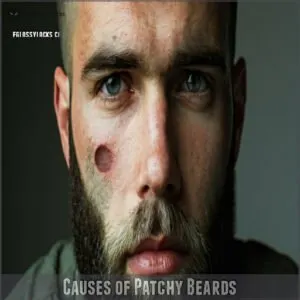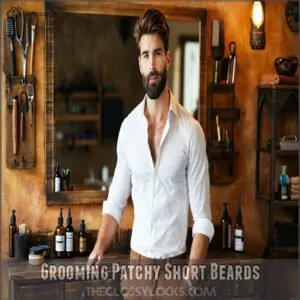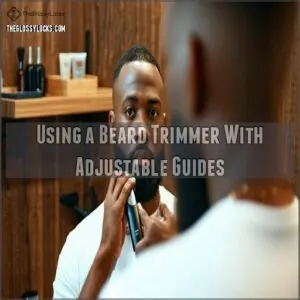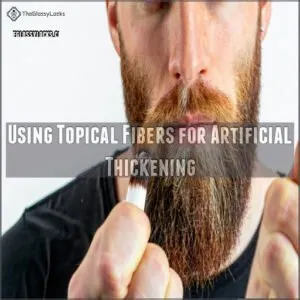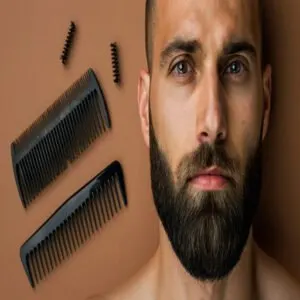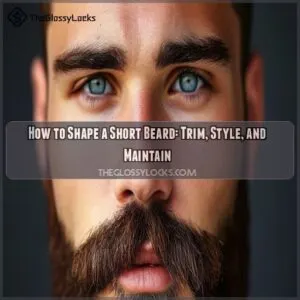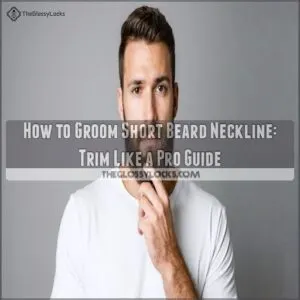This site is supported by our readers. We may earn a commission, at no cost to you, if you purchase through links.

Use a quality trimmer to create sharp, clean cheek and neckline edges, keeping your style defined.
Brush daily with a boar bristle brush to train hairs to cover gaps (it’s like combing over for beards, but better).
A beard balm or oil keeps hair conditioned and adds subtle thickness.
Want more coverage? Tinted fibers or beard dye can work wonders.
Focus on symmetry and blend those edges like a pro—because confidence beats perfection every time.
Ready to perfect your patchy beard game?
Table Of Contents
- Key Takeaways
- Causes of Patchy Beards
- Grooming Patchy Short Beards
- Trimming and Styling Techniques
- Maintaining a Healthy Beard
- Enhancing Patchy Beard Appearance
- Frequently Asked Questions (FAQs)
- What Products Should I Use to Groom My Short Beard?
- How Often Should I Trim My Short Beard?
- Can I Use a Razor to Shape My Short Beard?
- How Can I Prevent Beard Dandruff?
- Is It Possible to Grow a Thicker Beard?
- How do you fix a patchy beard on your cheeks?
- How to trim a beard that doesn’t grow on your cheeks?
- What length beard is best for patchy cheeks?
- How to trim a short patchy beard?
- How do I prevent beard dandruff effectively?
- Conclusion
Key Takeaways
- Let your beard grow for 4-6 weeks to better assess your natural growth patterns and see where patches may fill in naturally.
- Use a quality trimmer to create sharp edges on the neckline and cheek lines, focusing on symmetry and balance to minimize patchiness.
- Apply beard oil daily for hydration, brush with a boar bristle brush to train hairs, and use beard balm to tame stray hairs and add thickness.
- Enhance patchy areas with topical fibers or beard dye to create the illusion of fullness and maintain an intentional, polished appearance.
Causes of Patchy Beards
Patchy beards happen for a variety of reasons, including genetics, hormones, and lifestyle habits.
Understanding these causes can help you make informed decisions to encourage healthy growth and manage sparse areas effectively.
Genetic and Hormonal Influences
If your beard resembles a patchy lawn, blame it partly on your genes and hormone levels.
Testosterone and dihydrotestosterone (DHT) drive beard growth, but sensitive androgen receptors are key.
Sparse patches? That’s genetic factors at play or your beard growth hormones underperforming.
Even with sufficient testosterone impact, your beard’s response might vary, especially across those patchy cheek fixes.
Understanding the patchy beard causes can help you address the root of the problem, related to beard growth and hormone levels.
Lifestyle Factors Affecting Beard Growth
Thicker beards don’t always rely on perfect genes—sometimes, lifestyle factors set the tone.
Poor nutrition and stress disrupt your beard’s rhythm, tossing in frustrating gaps.
Establish solid nutrition plans and stress management routines.
Improve sleep patterns and adjust fitness regimens with proper calorie intake to fuel growth.
These beard growth tips can be helpful patchy cheek fixes for your grooming goals.
Understanding beard growth methods is essential to addressing patchy cheek issues effectively.
Medical Conditions and Beard Growth
Struggling with a patchy beard? Medical conditions might be the culprit, including Alopecia Areata or skin conditions like seborrheic dermatitis. These can disrupt hair growth hormones like testosterone.
Here’s what to watch for:
- Alopecia Barbae: Circular bald spots on the beard.
- Skin Conditions: Rash or irritation causing hair loss.
- Autoimmune Disorders: Targeting hair follicles.
- Hair Loss: Linked to hormonal imbalance.
- Beard Transplant: A solution for severe cases.
Maintaining a healthy beard requires understanding of beard care tips to address patchy growth effectively.
Grooming Patchy Short Beards
Grooming a patchy short beard is all about working with what you’ve got while creating a balanced, polished look.
With the right techniques, you can style your beard to highlight its strengths and minimize the appearance of sparse spots.
Letting The Beard Grow for Accurate Patch Assessment
Don’t obsess over early patchiness; facial hair growth has its rhythm.
Letting it grow for at least 4-6 weeks reveals your beard growth patterns.
This allows accurate patch assessment and highlights areas with potential.
Beard density varies during growth stages, so patience is key.
Resist trimming too soon—short beard styles thrive when you understand your natural patchy beard canvas.
Dietary Changes for Better Beard Growth
Tired of waiting for those cheek patches to fill in? Your diet plays a huge role in beard growth.
Focus on nutrient balance, healthy fats, and protein sources for better facial hair growth.
Load up on foods like:
- Eggs and chicken for protein and biotin.
- Spinach and sweet potatoes for Vitamin A.
- Brazil nuts to boost testosterone naturally.
Using Minoxidil for Beard Growth
Minoxidil, a popular beard growth product, often works wonders for patchy beards. By stimulating hair follicles and enhancing growth stages, it promotes fuller facial hair growth.
Applied twice daily, results can appear within 16 weeks, but consistency matters. Remember, patience is key!
While side effects like skin irritation are rare, verify you follow the treatment duration and directions for maximum beard thickening. Understanding the proper beard growth treatment is essential for achieving desired results.
Trimming and Styling Techniques
Trimming your short beard the right way can make patchy cheeks less noticeable and give your beard a polished look.
With the right techniques, like using adjustable trimmers and creating clean lines, you’ll shape a style that’s both sharp and balanced.
Using a Beard Trimmer With Adjustable Guides
Using a trimmer with adjustable guides gives you full control over your short beard trimming. Start with a longer trimmer setting, then adjust gradually for precision.
Follow these trimming techniques:
- Define patchy cheek beard lines with edge control.
- Trim against growth for an even cut.
- Use guide adjustments for consistent length.
- Check symmetry throughout.
- Always clean blades before use.
Investing in a high quality beard trimmer adjustable can make a significant difference in your grooming routine with the right edge control and proper use of a beard trimmer.
Trimming From Various Angles for Consistent Length
For consistent beard trimming, adjust your angle techniques to tackle uneven cheek hair growth.
This approach benefits from switching trimmer settings as you work along the jawline or cheeks.
Focus on facial symmetry by trimming from different angles—sideways, downwards, or upwards—depending on the patchy areas.
This beard trimming guide guarantees better length control and smooth, even results, ultimately leading to a well-maintained short beard.
Creating Sharp Lines for a Defined Look
Sharp lines elevate your beard’s look, creating a clean, polished appearance. For beard edging, follow natural contours. Use a trimmer to shape your neckline—start below the jawline crease for symmetry.
Enhance cheek definition with precise trimming tips, blending edges for natural beard lines. Master facial contouring by maintaining balance, checking angles, and ensuring beard shaping techniques align with overall beard symmetry.
Achieving a sharp look requires understanding beard trimming techniques to maintain a well-groomed beard.
Maintaining a Healthy Beard
Keeping your beard healthy is the foundation for improving its look and feel, even if it’s patchy.
With the right products and a consistent routine, you can keep your beard hydrated, shiny, and well-groomed.
Using Beard Balm for Moisture and Shine
Keeping your beard neat starts with good beard care. A quality beard balm locks in moisture, tames those stray hairs, and adds shine—perfect for patchy beard solutions.
Styling aids like beard balm help maintain control, especially with short beard maintenance. Look for balms with natural oils for hydration and easy shaping. It’s shine without the grease!
Using a beard care product can make a significant difference in the overall health of your beard.
Applying Beard Oil for Hydration and Shine
Beard oil can transform your patchy beard into a soft, shiny masterpiece. It hydrates dry skin and conditions hair, reducing itchiness and promoting healthy growth.
Apply a few drops daily for the best results.
- Warm oil between your palms before use.
- Massage it evenly into your beard and skin.
- Use oil blends for soothing hydration.
- Target dull hair with shine products.
- Choose beard growth products with jojoba or argan oil.
Using the right techniques and products, such as those with beard growth properties, can make a significant difference in the health and appearance of your beard.
Brushing Daily With a Boar Bristle Brush
Grab a boar bristle brush and make beard brushing part of your daily routine. Its natural bristles distribute oils evenly, improving beard health and reducing patchy spots.
This simple technique keeps short beard maintenance on track. Plus, it’s oddly satisfying—like giving your beard a tiny massage!
Remember, quality brush types matter, so invest in proper bristle care for effective beard grooming. Understanding beard brush benefits is vital for achieving the best results in beard care and maintenance.
Enhancing Patchy Beard Appearance
You don’t need a perfect beard to make a strong impression—just the right tricks to enhance what you’ve got.
Techniques like using topical fibers or dyeing can help patchy areas look fuller and more polished.
Using Topical Fibers for Artificial Thickening
When beard patchiness feels like a challenge, topical fibers can work wonders.
These hair densifiers cling to your existing facial hair, instantly creating the illusion of beard fullness.
Simply sprinkle or apply fiber products over sparse beard areas, using a beard filler tool for precision.
Fiber safety is key—choose trusted brands, and avoid inhaling particles during application to ensure a safe and effective use of beard filler tools.
Dyeing for a Uniform Color and Fuller Appearance
If topical fibers aren’t quite cutting it, beard dye can help you turn patchy cheeks into a fuller look.
By selecting a color matching your natural hair, you’ll achieve a uniform shade that minimizes uneven beard growth.
Prioritize dye safety by testing first and applying carefully.
A hydrated beard enhances the appearance, so use beard-specific conditioners afterward.
Understanding patchy beard styles is essential to maintaining a well-groomed appearance.
Frequently Asked Questions (FAQs)
What Products Should I Use to Groom My Short Beard?
People often say less is more, and that’s true here.
Stick with beard oil for hydration, beard balm to tame strays, a boar bristle brush for styling, and a quality trimmer for sharp edges.
How Often Should I Trim My Short Beard?
Trim your short beard every 5-7 days to maintain a clean, consistent look.
Regular upkeep helps manage uneven growth and patchy areas, keeping your beard sharp and well-shaped without letting stray hairs take over.
Can I Use a Razor to Shape My Short Beard?
Shaping your short beard with a razor is like fine-tuning a masterpiece—use it to define sharp cheek and necklines.
Be gentle, avoid over-shaving patches, and trust a steady hand for clean, crisp edges.
How Can I Prevent Beard Dandruff?
Hydrate your skin with beard oil daily to prevent dryness. Exfoliate weekly to remove flakes and improve circulation.
Use a specialized beard shampoo, and avoid harsh soaps.
Stay consistent—healthy habits keep dandruff under control!
Is It Possible to Grow a Thicker Beard?
Yes, a thicker beard is possible!
Focus on boosting testosterone with a healthy diet, exercise, and sleep.
Groom regularly, use beard oils, and consider biotin supplements.
Patience is key—growth improves with time and care!
How do you fix a patchy beard on your cheeks?
Focus on creating symmetry by trimming the fuller areas to match the patchy ones.
Use beard balm to control flyaways, brush daily to distribute oils, and grow it out for natural filling.
Patience pays off!
How to trim a beard that doesn’t grow on your cheeks?
Trimming a beard without cheek growth? Emphasize areas with fuller coverage like the chin or jawline.
Shape a defined neckline and cheek line, creating contrast.
Try styles like a goatee, chin strap, or bold stubble.
What length beard is best for patchy cheeks?
Stick to a short beard, ideally trimmed around 3-6mm.
This length keeps things neat while giving the illusion of fuller coverage.
Pair it with sharp edges and clean lines to define your look confidently.
How to trim a short patchy beard?
Shape your beard using a trimmer with adjustable guards, keeping cheeks shorter to blend patches.
Define clean lines on cheeks and neckline.
Brush daily, apply beard oil, and embrace the stubble for a balanced, intentional look, which helps to create a balanced appearance.
How do I prevent beard dandruff effectively?
Keep beard dandruff at bay by washing with a gentle beard shampoo, exfoliating to remove dead skin, and moisturizing with beard oil.
Stay hydrated, limit stress, and avoid harsh products to keep your skin healthy.
Conclusion
Think of your short beard like a blank canvas—patchy cheeks don’t mean you can’t create a masterpiece.
By letting it grow, grooming with sharp edges, and using tools like beard balm, oil, or fibers, you can maximize your beard’s potential.
Brush daily to train the hairs, focus on symmetry, and consider subtle enhancements like dye for a fuller look.
Confidence is key, and with these tips on how to groom a short beard for patchy cheeks, you’ll wear it proudly with a fuller look.
- https://cremocompany.com/blogs/blog/how-to-fix-a-patchy-beard
- https://in.braun.com/en-in/male-grooming/the-world-of-styling-and-trimming/how-to-fix-a-patchy-beard
- https://wimpoleclinic.com/blog/all-natural-ways-to-fix-a-patchy-beard/
- https://uk.braun.com/en-gb/male-grooming/beard-care/how-to-fix-a-patchy-beard
- https://www.ncbi.nlm.nih.gov/pubmed/7126460

